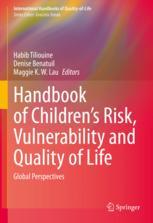图书简介
This handbook makes a major contribution to the growing international research and policy interest in children’s experienced well-being or quality of life in childhood, linking it to ongoing research on children’s risk and vulnerability. The editors and contributors adopt the broader concept of ‘risk’ in addition to ‘vulnerability’. Not much work considers the connections between risks that children experience and their quality of life. In examining children’s quality of life, the chapters discuss various issues of risk and vulnerability that may affect their lives and also how the quality of childhood might be enhanced and maintained even in the face of these factors. The chapters discuss experiences of violence and abuse; access to basic services such as housing, health and education; and children’s vulnerability due to broader external factors such as war, conflict, and environmental events. The volume also includes the impacts of new technologies on children and the consequent risks and vulnerabilities they may face, alongside the benefits.This important volume brings together a diverse range of perspectives from established experts and emerging scholars in these fields of work. It covers a wide range of geographical and cultural contexts, and includes theoretical, empirical, policy and practice-based contributions. This handbook is a natural first point of reference for academics and policy professionals interested in quality of life, well-being, and children’s rights.
1. Handbook of children’s security, vulnerability and quality of life: An introduction.- Part I Concepts of security, vulnerability and quality life.- 2. Adversity and child well-being: exploring recent research from different fields.- 3. The Value of Transnational, Qualitative Comparative Research on Children’s Vulnerability: Methodological and Epistemological Reflections.- 4. Ideological constructions of childhood: Considerations for children’s subjective well-being.- Part II Children’s perspectives of violence and safety.- 5. Well-being and Safety in Children from Buenos Aires, Argentina.- 6. Children’s perspectives on safety: the case of Greece.- 7. Negotiating safe spaces: Children’s discursive constructions of safety and vulnerability in a context of violence.- 8. About the fear of “the other”: contributions to reflecting on children’s opinions of safety from a political standpoint.- 9. A child standpoint on issues of safety in public places in diverse urban localities in eastern Australia.- Part III Peer relationships for children’s feelings of safety and quality life.- 10. Influence of vulnerability on subjective well-being and self-perceived safety among Bangladeshi children.- 11. Offline and online peer violence: Significance for child well-being in Southeastern Europe.- 12. Understanding bullying cases in Indonesia.- 13. Cyberbullying as a new form of aggression: a theoretical review and implications for adolescent well-being.- 14. What stops a good life for children? An exploration of bullying, poverty and gender.- 15. Victimization by peers and subjective well-being of Romanian school children.- Part IV The quality of life children in vulnerable contexts.- 16. The wellbeing of children in the vulnerable context of seasonal migrant workers in Turkey.- 17. How do working children feel about their lives? And why it matters that we know.- 18. The children of Palestine: Struggle and survival under occupation.- 19. Understanding the relations between access to healthcare, social capital, and health-related well-being of street-involved children in Ghana.- 20. The well-being and inclusion of children from Africa and the Middle East living in Malta.- 21. Understanding factors challenging children’s well-being in Algeria: A research synthesis.- Part V Interventions and practice.- 22. Programs to promote children’s wellbeing: from data to practice.- 23. Exploring after-school activities by socio-demographic characteristics and subjective well-being.- 24. Children’s standpoint on Vulnerability: Implications for social work Practice with children and young people.- 25. Family foundations: improving our understanding of what neglect in adolescence means, the harm it causes and how to respond.- 26. Specificities of the subjective quality of life of children involved with the child welfare system.- 27. A quality of life perspective on vulnerability: The case of young people in Flemish youth care.
Trade Policy 买家须知
- 关于产品:
- ● 正版保障:本网站隶属于中国国际图书贸易集团公司,确保所有图书都是100%正版。
- ● 环保纸张:进口图书大多使用的都是环保轻型张,颜色偏黄,重量比较轻。
- ● 毛边版:即书翻页的地方,故意做成了参差不齐的样子,一般为精装版,更具收藏价值。
关于退换货:- 由于预订产品的特殊性,采购订单正式发订后,买方不得无故取消全部或部分产品的订购。
- 由于进口图书的特殊性,发生以下情况的,请直接拒收货物,由快递返回:
- ● 外包装破损/发错货/少发货/图书外观破损/图书配件不全(例如:光盘等)
并请在工作日通过电话400-008-1110联系我们。
- 签收后,如发生以下情况,请在签收后的5个工作日内联系客服办理退换货:
- ● 缺页/错页/错印/脱线
关于发货时间:- 一般情况下:
- ●【现货】 下单后48小时内由北京(库房)发出快递。
- ●【预订】【预售】下单后国外发货,到货时间预计5-8周左右,店铺默认中通快递,如需顺丰快递邮费到付。
- ● 需要开具发票的客户,发货时间可能在上述基础上再延后1-2个工作日(紧急发票需求,请联系010-68433105/3213);
- ● 如遇其他特殊原因,对发货时间有影响的,我们会第一时间在网站公告,敬请留意。
关于到货时间:- 由于进口图书入境入库后,都是委托第三方快递发货,所以我们只能保证在规定时间内发出,但无法为您保证确切的到货时间。
- ● 主要城市一般2-4天
- ● 偏远地区一般4-7天
关于接听咨询电话的时间:- 010-68433105/3213正常接听咨询电话的时间为:周一至周五上午8:30~下午5:00,周六、日及法定节假日休息,将无法接听来电,敬请谅解。
- 其它时间您也可以通过邮件联系我们:customer@readgo.cn,工作日会优先处理。
关于快递:- ● 已付款订单:主要由中通、宅急送负责派送,订单进度查询请拨打010-68433105/3213。
本书暂无推荐
本书暂无推荐
















